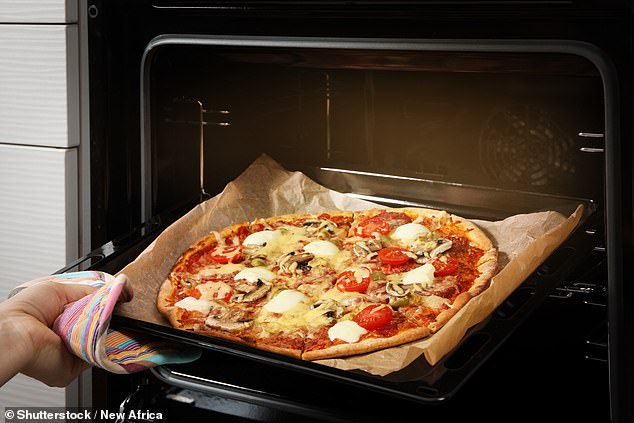Whether you prefer stuffed crust, extra cheese or even some controversial pineapple, we all enjoy tucking into a pizza.
But instead of just chucking one in the oven, you should think carefully about where you place it, experts have warned.
In order to recreate restaurant-standard pizza at home, choosing which rack to put it on is key.
And placing it on the top shelf is a recipe for disaster, according to a professional.
Michael Forbes, Product Expert at the home and kitchen appliances company AEG UK, said placement can affect how evenly the crust bakes and how well the toppings cook.
‘These are tips and tools that anyone can use to make restaurant-quality pizza at home,’ he said.
For best results he recommends using a hot pizza stone, which helps hold and evenly distribute heat while cooking.
But for those who don’t own one of these, read on to find out his advice – and see whether you agree.

When putting your pizza in the oven you have to take several factors into account – including the temperature, choice of shelf and cooking time
Placing it on the middle shelf of a traditional oven is best for achieving an even cook, he advised.
Meanwhile the bottom shelf can achieve a crispier crust – but watch for over-browning.
The top shelf, however, is likely to lead to an undercooked base and too-crisp toppings.
A pizza stone, preheated for 30 minutes and placed on the middle or bottom shelf, is ideal for a pizzeria-style crust, Mr Forbes said.
Using the right oven settings is also important, he explained, adding: ‘On some new ovens, there’s a setting specifically dedicated to homemade pizza, but if not, aim for 240-250°C (464-482°F) or the hottest setting available if your oven maxes out before this.
‘The goal is to achieve even air circulation and heat from both above and below to create the perfect balance of bubbling cheese, rich sauce, and a crispy crust.
‘Cook your pizza for 7-9 minutes if it has a thin crust, or for up to 12 minutes if it has a thick crust.’
While the best results come from using a pizza stone – designed to absorb moisture, help develop a crisp base and distribute heat evenly – turning a baking tray upside-down can achieve a similar effect.

Pizza has boomed in popularity in the UK – even with the royals. Pictured: Queen Camilla receiving a pizza in Rome this week

Some ovens now have a ‘pizza’ or ‘frozen food’ setting, which can help achieve the desried result, Mr Forbes said
For those making their pizza from scratch, using the right flour for the dough is also important, he said.
To get a smooth dough texture, he recommends using Italian Tipo ’00’ flour, which is finely ground and makes for a soft but elastic dough that’s easy to work with and yields a light, airy crust.
Letting the dough rest – ideally for 24 hours but overnight would also work – allows the flavours to develop.
‘Cooking pizza requires a precise balance of heat,’ Mr Forbes said.
‘In a traditional pizza oven, the intense heat of the oven floor crisps the base, while the surrounding air heats and melts the toppings.
‘To replicate this in a conventional oven, always use the lowest shelf level and include bottom heat along with hot air cooking.
‘This combination provides the intensity needed for a deliciously crisp base and perfectly melted cheese.
‘Look out for a specific ‘pizza setting’ or even a ‘frozen food setting’ on your oven, as these can help achieve the desired results.
‘And remember, always avoid using the top shelf to maintain that traditional pizza taste!’
Data suggests the UK is a nation that favours meaty toppings, with pepperoni reigning supreme.
Meat feast comes a close second, and in third place is ham and pineapple.
In 2024, 65 per cent of Britons said they had either dined in or ordered takeaway from pizza and Italian restaurants.
This article was originally published by a www.dailymail.co.uk . Read the Original article here. .

